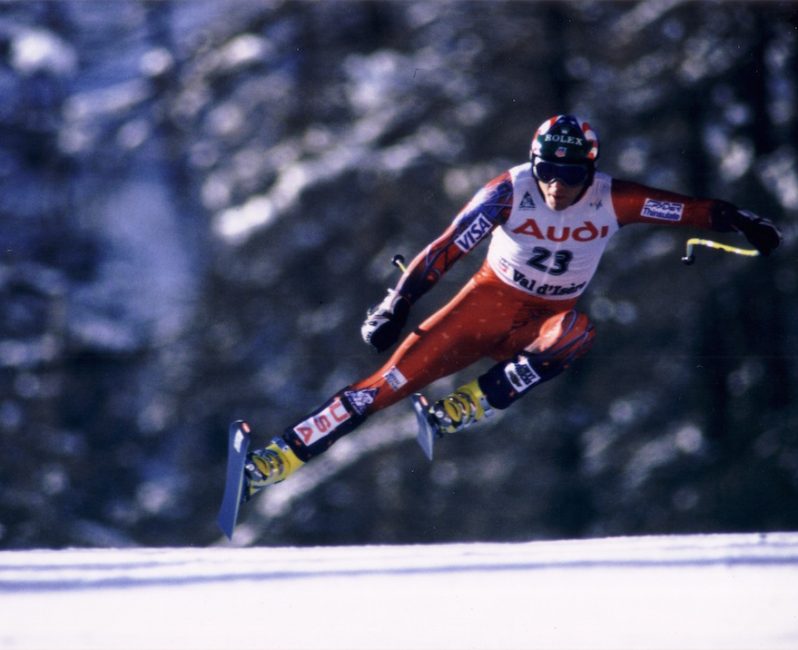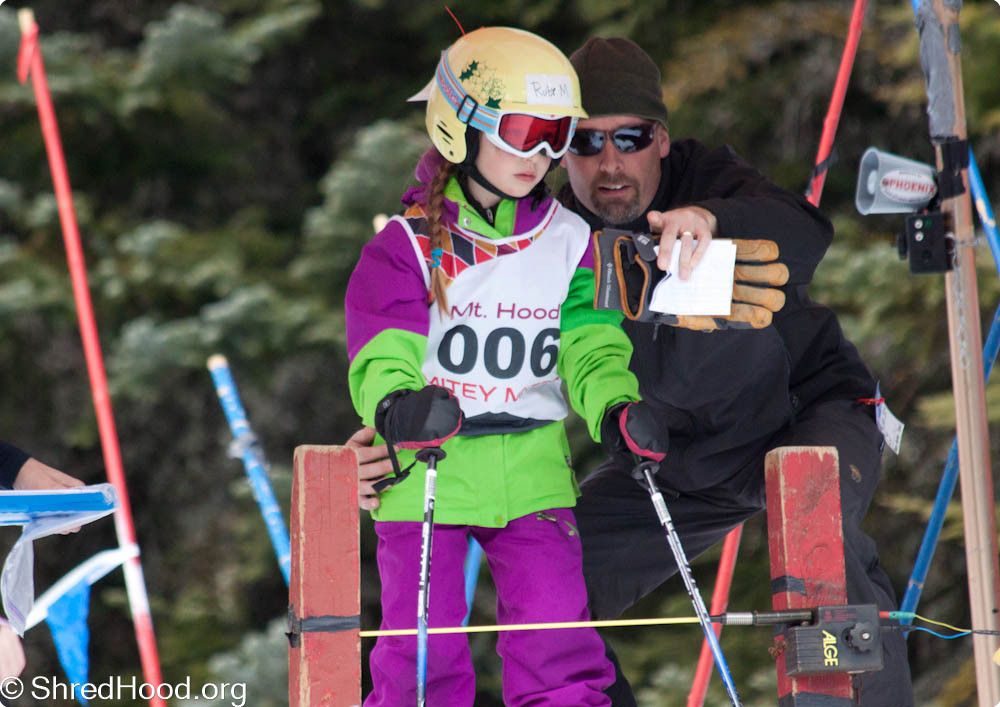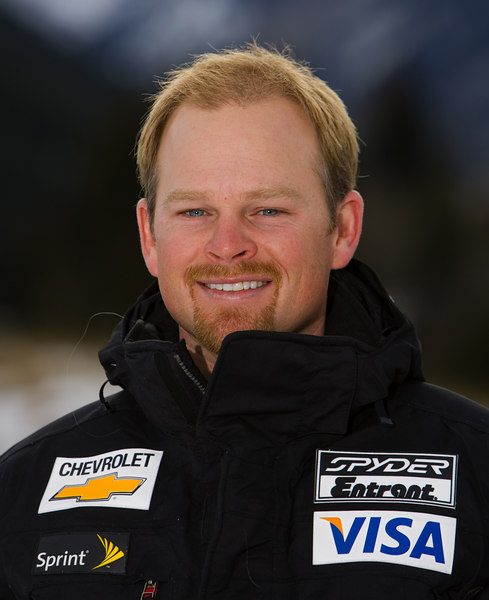AJ Kitt is a familiar character around Mount Hood, a family guy with three young kids, a ski racing coach, a hard-working real estate pro who helps run his wife Amy’s vacation rental business. Just a regular Oregon guy, who also happens to be one of the greatest American ski racers in history: winner at Val-d’Isère, silver medalist at the Hahnenkamm, a four-time Olympian.
I met AJ through my daughter Melina’s racing with Meadows Race Team, where AJ coaches and where his triplets Ayden, Aksel and Ava train and compete. Fortunately for us, Melina got into a group of ripping young under-12 racers coached by a guy who knows what it’s like to catch air doing 60 and land on a sheet of ice doing 85 or 90. Not that I would ever want my daughter to try that maneuver, mind you, but still, it’s pretty cool that her coach has experienced the sport of ski racing at that elite level.
Kitt grew up in Rochester in Western New York skiing Swain Resort, found his line down the steep ice at Whiteface, made the U.S. Ski Team at the age of 19 and competed all over the world for 11 years on the World Cup tour, including the Winter Olympics in Alberta, Canada, Albertville, France, Lillehammer, Norway, and Nagano, Japan. He took third in the downhill in the 1993 World Championships, and for a while he was the number-one-ranked downhill racer in the world.
I’m not much of a racer myself, but I love the sport, especially the downhill. So I jumped at the chance to sit down with AJ Kitt and hear more about his experiences. Between his real estate work, his triplets, his coaching and his side work traveling to various mountains as a pacesetter for NASTAR, he is a busy guy. We managed to find time to talk over the din in a crowded lodge packed with coaches, athletes, parents, race officials, and all sorts of skiers and snowboarders grabbing a quick lunch before heading back onto the mountain. Our conversation is edited for brevity.
Shred Hood: I appreciate the work you do with the kids. Is this what it was like for you growing up as a racer?
AJ Kitt: It’s changed. We didn’t really have small groups broken up by age or anything. We just had a lot of coaches and a bunch of kids. Just big groups of people.
When did you figure out you were good at it?
Not until I was about 17. I was kind of struggling to get the results I wanted, but then that one season I discovered that I was pretty good at downhill. I started winning races, and I thought, okay, this is starting to click. That’s when I started getting some attention.
You got to race downhill at a young age.
Well, I went to a ski academy at Whiteface in Lake Placid, and this was after the Olympics had been there. So the program was really set up there. But you’re right, as J2s, which today would be a U16 (athletes under 16), we were pretty regularly running downhill. Back when I was that age, there was no Super G, there was just downhill.
Did you take to it right from the beginning or was the speed a bit daunting?
I didn’t know any different. It certainly didn’t bother me any, going that fast. I’m sure my parents weren’t happy about it—as a parent I don’t think I’d be happy about it with my kids—but I don’t remember it being something that bothered me.
You were skiing World Cup by 19, right?
Yeah, I went from being a 17-year-old thinking maybe I’m pretty good at this, to two years later being in the Olympics. That was a big stretch, a good change in life. Hanging out with Billy Johnson, hanging out with the big guys. It happened quickly for me.
Did you take to it? I can see how that might be tough when you’re still a teenager.
I went into it with zero expectations. I just wanted to go get World Cup experience and see what it was all about. Same with the Olympics. I had no expectations going there for the first time. So that took a lot of pressure off me and made it a whole lot easier. But a year later I was gunning for the top of the podium. Those things come quickly once you get comfortable with your environment and your surroundings and what you’re doing. You start to push those limits.
What was the race where it first really clicked for you?
There were some training runs that I remember. But then on race day, nerves or whatever would get me. Or maybe the faster guys were holding up a little on training days but going harder on race days. I was still doing okay on race days, getting top 10s. But I starting consistently winning training runs, and I thought, okay, this is a pretty good sign. It started to feel more realistic. And probably the big breakthrough was in Val-d’Isère. I went first, third, first in the training runs, and I thought, okay, I got this. This course is mine. I know it. And I ended up like 15th, and I was so disappointed. 15th was really good, all of my teammates were back in the 30s, 40s, 50s, and I was head down, all disappointed. There were mad at me for being disappointed in a 15th place because they wouljd have killed for 15th place. That’s when I realized that a bad day for me was still a good day. That whole experience allowed me to settle down and perform a little better on race day, knowing what I needed to do, having made the mistakes in the past.
That was a big breakthrough, because throughout that year I was cvonsistently in the top 20 in every race, and then the next year I went back and went first, third, first in the training again, and then I won the race by a huge margin. Next week I was third, two weeks later I was second. I was leading the downhill standings midway through the season.
Was there a certain skill that enabled you to reach the top?
I couldn’t buy a turn to save my life in those days. Technically I just wasn’t very good. I just relied on my gliding skills. I was the fastest glider. That for some reason really clicked. I won every gliding section for years and years.
Are you extremely flexible?
No. It’s not flexibility. A big part of it is having a soft touch on the snow. If you’re all stiff and rigid you’re like a rock rolling down the hill. Whereas if you are soft and supple you’re more like water flowing down the hill and you can absorb the rolls a lot more easily.
Which is hard when you’re going so fast.
Yeah, it’s hard to get yourself to relax. The mental game was always a strength of mine. I was just confident in my approach to competition, and that allowed me to be relaxed on race day.
How long were you able to avoid injuries?
Pretty long. I started on the World Cup in 88 and it wasn’t until 95 when I got my first season-ending injury. But then after that, I never really came back to the level I wanted. The sport was changing, the equipment was changing. The year I missed was the year they introduced all the new technology for skis and boots, and a whole new breed of athletes came in, guys like Hermann Maier, Stephan Eberharter, more technical GS racers. And then they started setting the courses turnier… At Kitzbühel they run it in about the same times that we ran it. But there’s three more turns, and the turns that were there are way more across the hill.
Speaking of Kitzbühel, it must be something else to look down at that course from the starting gate. I mean, that’s steep.
You know, kicking out of the start, it’s not that steep. It kind of goes to a sidehill, so you’re traversing on your edge, controlling your speed to a degree. But six seconds into it, you’re flying off the Mausefalle, and the Mausefalle jump is blind. So you’re heading into something, you see the lip of the jump and you see the valley on the other side, but you don’t see where you’re going to land. It’s down in a hole.
And you’re going how fast when you launch off there?
You’re probably going 60 when you launch, and about 80 when you land. So you kick out of the start, you’re going zero to 60 in three seconds, and you leave the ground and land a few seconds later going 85. So you’re going zero to 85 in eight seconds. It feels like you’re dead asleep at your home, and somebody walks in with an ice-cold pail of water and throws it on you. It’s like, Wake up.
How many times did you run it?
Probably 30 overall, I raced it nine.
Did you ever crash?
I crashed once, not so bad. I wasn’t going too fast.
Do you have lingering injuries?
I’ve had reconstructive surgery on my knee twice, so that bugs me. It’s hurting right now, but it’s one of those things that you live with. It doesn’t slow me down any.
What are your goals when it comes to coaching kids?
I try to encourage them and help them feel confident, but mostly I’m just trying to get them to become better technical skiers. I want them to have fun, and I want skiing for them to be a life-long sport. It that’s all they get out of it, then I’ve succeeded. And if anybody can go beyond that and get a scholarship to college or make the US Ski Team or go to the Olympics, well that’s a huge bonus.
Last modified: February 19, 2016



